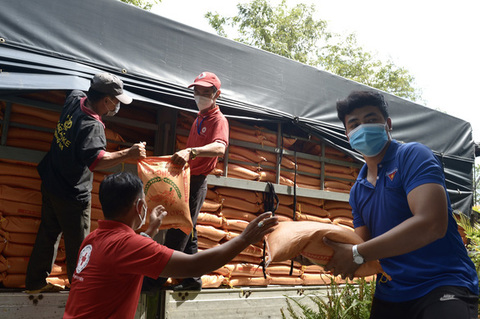
Members of the Red Cross Society in HCM City's Binh Chanh District unload rice to distribute to poor locals. People in HCM City are set to get over 14,500 tonnes of free rice from the national reserve by September 10. — Photo tuoitre.vn
The General Department of State Reserves is giving 14,500 tonnes of rice from the national reserve for free distribution to HCM City's struggling populace.
It has tasked the HCM City State Reserves Department to work with the city and Long An Province administrations to distribute the free rice to people in need.
In Long An, which is also under strict preventive measures, 807 tonnes will be distributed.
The distribution must be completed by September 10.
Last week Deputy Prime Minister Le Minh Khai had instructed the Ministry of Finance to distribute 130,000 tonnes of rice from the reserve to people in 24 provinces and cities.
HCM City is slated to receive the largest volume: over 71,000 tonnes.
HCM City is focusing on distributing food to its residents, who are prohibited from leaving their homes to shop.
A working group set up by the Ministry of Agriculture and Rural Development has proposed collaborating with businesses and co-operatives to supply up to 10,200 tonnes of food and foodstuffs daily to meet demand.
According to the ministry, HCM City requires 7,600 tonnes a day.
Many businesses have made preparations and could supply large quantities of food, according to the working group.
The group has called on agriculture departments across the south to ensure sufficient supply to HCM City.
It has been trialling a programme to supply 10kg packs of agriculture produce from other provinces under which businesses can sign up to sell and deliver such packs directly to consumers.
Delta provinces are keen to supply food to the city.
The group has urged the city to expand this programme.
HCM City, Viet Nam’s COVID epicentre with over 190,000 cases, has instructed the public to "stay where they are” at all times and strictly follow safe distancing between individuals, families, residential quarters, and wards.
It is helping people get food and groceries without leaving home by having organisations such as the Women's Union, community-based COVID-19 prevention teams and other voluntary groups work with the police and military to deliver them. — VNS